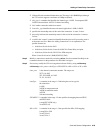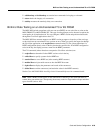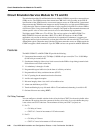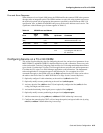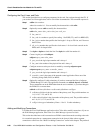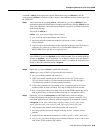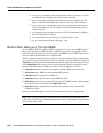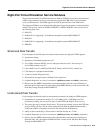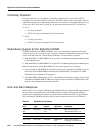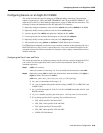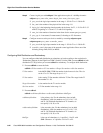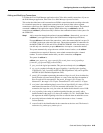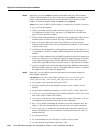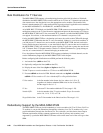
Card and Service Configuration 6-41
Eight-Port Circuit Emulation Service Modules
Eight-Port Circuit Emulation Service Modules
The main function of the Circuit Emulation Service Module (CESM) is to provide a constant bit rate
(CBR) circuit emulation service by converting data streams into CBR AAL1 cells for transport
across an ATM network. The CESM supports the CES-IS specifications of the ATM Forum.
The eight-port CESM lets you configure individual physical ports for structured or unstructured data
transfer. The card sets consist of an MGX-CESM-8T1 or MGX-CESM-8E1 front card and one of
the following back cards:
• RJ48-8T1
• R-RJ48-8T1 for supporting 1:N redundancy through the optional MGX-SRM-3T3
• RJ48-8E1
• R-RJ48-8E1 for supporting 1:N redundancy through the optional MGX-SRM-3T3
• SMB-8E1
Structured Data Transfer
If you configure an individual port for structured data transfer, the eight-port CESM supports:
• Synchronous timing.
• Superframe or Extended Superframe for T1.
• N x 64 Kbps, fractional DS1/E1 service (contiguous time slots only). You can map an
N x 64-Kbps channel to any VC.
• CAS robbed bit for T1 (ABCD for ESF and SF frames) and CAS for E1 (channel 16).
• CCS channel as a transparent data channel.
• A choice of partial-fill payload sizes.
• Idle detection and suppression for 64-Kbps CAS connections.
• Loopback diagnostics on a line or a connection (addlnloop, tstcon, and tstdelay commands).
• Bit error rate test (BERT) functionality with loopback pattern generation and verification on
individual lines or logical port. For a description of the BERT functions, see the section titled “Bit
Error Rate Testing Through an MGX-SRM-3T3.”
Unstructured Data Transfer
If you configure an individual port for unstructured data transfer, the eight-port CESM supports:
• Synchronous or asynchronous timing at T1 (1.544 Mbps) or E1 (2.048 Mbps) rates. For
asynchronous timing, you can select its basis as either SRTS and adaptive clock recovery.
• The special port type framingOnVcDisconnect. This port type prevents a remote-end CPE from
going to LOF by placing a line in remote loopback mode when the CESM determines that a
connection deletion or suspension occurred at the network-side ATM interface.
• Ability to detect and display a yellow alarm for the ESF framing on a T1 line.
• Loopback diagnostics on a line or a connection (addlnloop, tstcon, and tstdelay commands).
• Bit error rate test (BERT) functionality with loopback pattern generation and verification on
individual lines. For a description of BERT functions, see the section “Bit Error Rate Testing
Through an MGX-SRM-3T3.”



